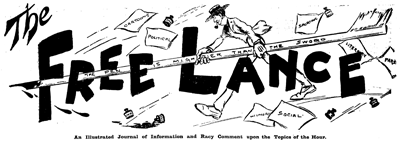- Newspapers
- Explore
- Free Lance

Free Lance
Available issues
Background
Region
Wellington
Available online
1900-1920
Also published as:
New Zealand Free Lance
The Free Lance was one of New Zealand’s most popular weekly, pictorial newspapers. It was first published in Wellington in 1900 by Geddis and Blomfield as a spin-off from their successful Auckland weekly, the NZ Observer and Free Lance. The publishers split the title, with the Auckland paper becoming the NZ Observer and the Wellington paper taking the name Free Lance.
Despite its initial association with the Observer, the Free Lance soon developed as a separate publication with the Geddis family concentrating on the Free Lance and Blomfield the Observer. The editor James McRobert Geddis (1856-1935) later became sole proprietor and in 1920 the Geddis family formed a private company to run the paper. The Geddis family were involved with the management of the Free Lance until it was incorporated into the New Zealand Weekly News in 1960. Its demise left the Weekly News as the last pictorial weekly in New Zealand.
The Free Lance was a typical weekly; conservative and mainstream with much coverage given to royalty, New Zealand scenery, high society and sport. It was noted for its political cartoons. It carried the work of some of the country’s top cartoonists including John Gilmour, Gordon Minhinnick, Tom Ellis (Tom Glover), E.F. Hiscocks and Stuart Peterson. The Free Lance was fortunate to begin publishing at the same time as there was a flowering of local cartooning talent. The Free Lance not only benefited from this but also played a significant role in fostering this talent and pictorial journalism in general.
Copyright statement
For material published 120 or more years ago, to the best of the National Library of New Zealand's knowledge, under New Zealand law, no copyright exists in that material. You can copy that material, share it, and post it on a blog or website. It can be modified, remixed and built upon. It can be used commercially. If reproducing this material, it is helpful to include the source.
For material published fewer than 120 years ago, the following statement applies.
See our copyright guide for information on how you may use this title.